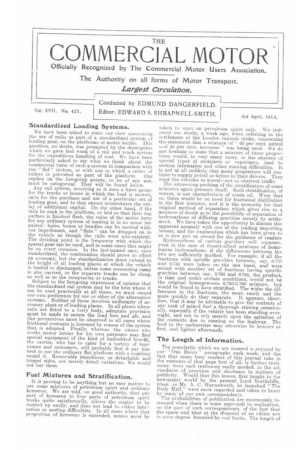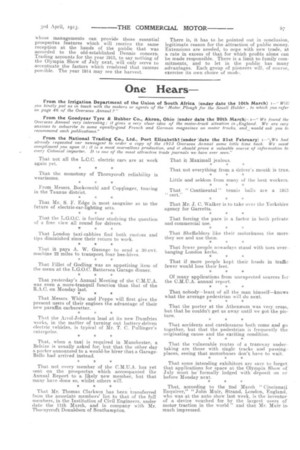Standardized Loading Systems.
Page 1

Page 2

Page 3

If you've noticed an error in this article please click here to report it so we can fix it.
We have been asked to state our view concerning the use of rails, as part of a standardized system of leading gear, on the platforms of motor lorries.This question, no doubt, was prompted by the description which we gave last week of a rail and truck system for the expeditious handling of coal. We have been particularly asked to say what we think about the commercial value of such a system in comparison with the " fiat" system, or with one in which a series of rollers is provided as part of the platform. Our replies on the foregoing points, to be of any use, must be categorical. They will be found below.
Any rail system, involving as it does a fixed gauge for the trucks or boxes in. which the load is stowed, calls for the purchase and use of a particular set of loading gear, and to that extent necessitates the outlay of additional capital. On the other hand, if the rails be sunk in the platform, or laid so that their top surface is finished flush, the value of the motor lorry for any ordinary system of loading is in no sense impaired: bales, boxes or bundles can be carried without impediment, and "flats" can be dropped on to the vehicle as though the rails were non-existent. The deciding point is the frequency with which the special gear can be used, and in some cases that might be on every occasion. In the last-named case, once standardized, the combination should prove to effect an economy, but the standardization must extend to the height of all loading places at which the vehicle is loaded or discharged, unless some connecting ramp is also carried, or the separate trucks can be slung, as well as to the receptacles or trucks. Subject to the foregoing expression of opinion that the standardized rail system may be the best where it can be used practically at all times, we must record our own preference for one or other of the alternative systems. Neither of these involves uniformity of accessory plant or of loading places. In all places where rails are fitted to a lorry body, adequate provision must be made to secure the load fore and aft, and like precautions must be observed in all cases where frictional restraint is lessened by reason of the system that is adopted. Finally, whereas the owner who works motor lorries for his own purposes may find special equipment of the kind of undoubted benefit, the carrier, who has to cater for a variety of businesses and customers, will probably find it pay him best to use the ordinary fiat platform with a combing round it. Removable stanchions. or detachable and hinged sides, are merely detail variations. We would not bar them.
Fuel Mixtures and Stratification.
It is proving to be anything but an easy matter to use some mixtures of petroleum spirit and ordinary kerosene. We are told, on good authority, that one part of kerosene to four parts of petroleum spirit works quite satisfactorily, allows the engine to be started LID easily, and does not lead to either lubrication or sooting difficulties. In all cases where that proportion of kerosene is exceeded. means must be
taken to start on petroleum spirit only. We indicated our doubt, a week ago, when referring to the settlement of the London taxicab strike, concerning the statement that a mixture of " 60 per cent. petrol and 40 per cent. kerosene" was being used. We do not hesitate to state that a mixture of those proportions: would, in very many cases, in the absence of special types of atomizers or vaporizers, lead to serious lubrication and other running difficulties. It is not at all unlikely that many proprietors will continue to supply petrol as before to their drivers. They want the vehicles to travel—not to obstruct traffic. The interesting problem of the stratification of some mixtures again presents itself. Such stratification, of course, is not characteristic of crude oil. Were that so, there would be no need for fractional distillation in the first instance, and it is the necessity for that original method of separation which gives rise to a measure of doubt as to the possibility of separation of hydrocarbons of differing gravities merely by settlement. We have taken the opportunity to discuss this apparent anomaly with one of the leading importing houses, and the explanation which has been given to us is now put on record for the guidance of readers.
Hydrocarbons of various gravities will separate, even in the case of closely-allied mixtures of homologous hydrocarbons, if the differences between the two are sufficiently marked. For example, if all the fractions with specific gravities between, say, 0.730 and 0.755 were taken on the one hand, and were mixed with another set of fractions having specific gravities between, say, 0.760 and 0.785, the product, in time and under certain conditions, would. not be the original homogeneous 0.750-0.760 mixture, but would be found to have stratified. The wider the differences in the fractions, the more easily and the more quickly do they separate. It appears, therefore, that it may be advisable to give the contents of any tank of mixed fuel a thorough stirring occasionally, especially if the vehicle has been standing overnight, and not to rely merely, upon the agitation of the contents due to running on the highway. The feed to the carburetter may otherwise be heavier at first, and lighter afterwards.
The Length of Information.
The popularity which we are assured is enjoyed by our "One Hears" paragraphs each week, and the fact that many. busy readers of this journal take in the contents of that page first of all, is further testimony. were such testimony really needed, to the advisedness of precision and shortness in matters of publicity. Would that this lesson, first taught to the newspaper world by the present Lord Northcliffe, when. as Mr. A. C. Harinsworth, he launched "The Daily Mail," were more regarded and taken to heart by many of our own correspondents. The probabilities of publication are enormously increased when there is some approach to realization. on the part of such correspondents, of the fact that the space and time at the disposal of an editor are in seine degree bounded by real limits. The length of information which reaches most editors is appayently seldom considered by the senders, although we are quite happy to admit that in our own case there are a few brilliant exceptions. Undue length is as risky as entire absence, in respect of advices.
The secret of successful publicity is not to cover sheet after sheet of circular letter with matter that. devoid of general interest, can stand no possible chance of insertion. The secret, rather, is to keep down the length of such information as nearly as possible to the bare communication of the essential facts which it is desired to place before readers. An editor, with more or less success, we know, after poring over the numerous lengthy screeds which reach him week after week, does his best to extract the kernel from even the most tedious compilations. In his heart. none the less, every editor—since he is only human—thinks well of the correspondent, be he advertiser or subscriber, who goes straight to the point that he desires to see brought before the public with which that editor is concerned.
We are not prompted to make the above brief reference to a topic of the utmost importance to the industry at large by reason of the reception of any one particular pile of sheets from one source, but it should be to the advantage of some who study our pages, to be told that it bodes ill for their publicity campaign when successive advices are so long that members of the staff find them "too gigantic "—either for condensation by way of precis or for the discovery of submerged yet suitable contents. With every respect to the perception of those who are not within the fold of journalism, THE COMMERCIAL Melton, with the Royal and Olympia Shows looming ahead, enters this plea, as much in their interests as in our own, that points for readers should he to the point. A good example is found in the way Bristol worthies are booming their city in advance of the Royal Show. We have annexed a few, of their well-chosen phrases, by way of introduction, on page 88A.
Finally, in defence against a possible charge of egotism, we confess that a recent conversation with the manager of a leading daily newspaper, and not our own limited experience in journalism, is the justification for these lines.
The Revival of Public Interest.
The successful flotation of Dennis Bros. (1913), Ltd., has furnished additional proof that there is a revival of public interest in commercial motoring. The unhappy results which followed the public support that was accorded to various motorbus undertakings in the years 1905 and 1906 have been tardily forgotten, but the undoubted strength of to-day's position on the heavy side of the industry is bound to tell. The reestablishment of the, ugly duckling" of the motor world has been gradual, but it has been none the less sure.
Our oft-repeated prophecy, concerning the unavoidable effects of the rehabilitation of the motoi* bus as a profit-earning vehicle, is now shown to bell quite sound, and some of our supporters on the inotorvan side, who have, during the last two or three years, been inclined to take us to task because of our sustained attention for and touch with motorbus and allied interests, will be the first to admit the significance of this all-round revival of public interest.
The significance of the successful public issue of an industrial undertaking, at a time when gilt-edged securities are being left on the hands of underwriters to extents varying between 70 per cent. and 90 per cent of the amount underwritten, cannot be magnified. It can mean nothing else but marked discrimination in favour of a branch of production for which it is believed the future is assured. Naturally, when this attitude of the public mind is but an endorsement of the future which we have ourselves foreseen since the establishment of THE COMMERCIAL MOTOR more than eight years ago, and in the case of the writer himself ever since his first indentification with utility vehicles no less than 17 years ago, we welcome this responsiveness. Its effects will be farreaching. Further outcome will undoubtedly be seen in the offering to the public of first-rank undertakings.
Be it noted, however, that the public is in no mood to put up money on the strength of estimates alone. There must be a series of certified and realized profits for a term of years, and it is the companies whose managements can provide those essential prospectus features which will receive the same reception at the hands of the public that was accorded to the old-established Dennis concern. Trading accounts for the year 1913, to say nothing of the Olympia Show of July next, will only serve to accentuate the factors which rendered that success possible. The year 1914 may see the harvest. There is, it has to be pointed out in conclusion, legitimate reason for the attraction of public money. Extensions are needed, to cope with new trade, at a rate in excess of that for which profits alone can be made responsible. There is a limit to family commitments, and to let in the public has many advantages. Each group of pioneers will, of course, exercise its own choice of mode.






















